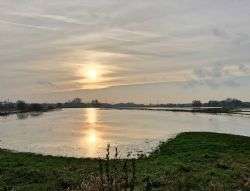Research aims to support farmers to bring back saltwater-damaged land after coastal flooding

Researchers from the University of Lincoln are embarking on a major new study to work out the true economic cost of coastal flooding and how farmland damaged by saltwater can best be brought back into use to support Lincolnshire's agricultural industry.
The study, delivered in collaboration with farmers operating in and around the Lincolnshire Wash, is funded by the University of Lincoln with a grant of £72,000 from its Research Investment Fund.
The project will be led by Dr Gary Bosworth, a leading specialist in the resilience of rural economies based in Lincoln's new School of Geography. He will be supported by Dr Iain Gould, a soil scientist from the Lincoln Institute for Agri-food Technology based at the University's Riseholme Campus and Dr Zhongwei Xing, an economist from Lincoln International Business School.
The team of scientists and economists will consider the potential economic impact caused by coastal flooding, including the long-term effects of increased levels of soil salinity on agricultural land. This will include modelling future scenarios of potential sea level rises and resultant impact on soil salinity levels in England's east coast. The results will be freely available and be used to engage policy stakeholders to provide an independent assessment of flood defence strategies and potential mitigation strategies in the Wash region of the county.
Dr Gary Bosworth said: "The threat posed to British agriculture by climate change and rising sea levels cannot be underestimated. Three years ago storm surges breached some of the coastal defences along England's east coast. Thankfully the damage to life and property was not comparable to earlier floods in 1953, but the hidden impact on the quality of our prime agricultural soils is still being felt by farmers today. One of the primary climate change forecasts is that sea levels may well rise and this, combined with potential changes in storm intensity, may increase flood risk.
"We hope by setting out the economic costs of saltwater contamination of farmland we can make the case for a greater policy focus on mitigation and adaptation strategies. We are also optimistic that we can offer practical solutions by improving scientific and industry understanding the most effective mitigation and adaptation measures."
The East of England was struck by devastating coastal flooding from a huge storm tide on the night of 31st January 1953. More than 300 people were killed in Lincolnshire, Norfolk, Suffolk and Essex with many more fatalities at sea and in the Netherlands. It is considered one of 20th century Europe's worst natural disasters.
The impact on the prime agricultural lands of Lincolnshire and the Eastern Counties was felt for decades after the floods receded, with around 160,000 acres of English farmland contaminated by saltwater.
Three years ago (December 2013) the east of England experienced the most severe tidal surge since the 1953 flood with sea levels rising by almost six metres in places. More than 2,000 acres of farmland was flooded with some of the most serious breaches south of the Humber and around Boston.
Dr Iain Gould said: "Seawater inundation leaves residues of salts, such as sodium, on the soil – high concentrations of which can damage soil structure for years. Although farmland can recover over time and various mitigation measures, in the worst cases, deep soil structure is so badly damaged farmland can be left unable to support commercially-viable production for sustained periods."
Provided by University of Lincoln



















